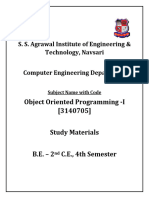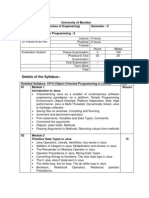Java Programming Trend Analysis
Uploaded by
chaitanykumavat25Java Programming Trend Analysis
Uploaded by
chaitanykumavat25Analysis of Trends and High-Probability Questions for Upcoming Exams
After analyzing the model answer papers from Summer 2019, Winter 2019, and Winter 2022 for the
Java Programming
subject (subject code: 22412), the following patterns and trends emerge:
Common Topics Across Papers
1. Basic Concepts:
- Features of Java (e.g., Platform Independence, Robustness).
- Definitions and uses of Class, Object, Constructor, and Thread.
2. Programming Basics:
- Types of Inheritance.
- Methods for file handling (e.g., FileReader, FileWriter).
- Access Specifiers (private, protected, public).
3. Programming Logic:
- Writing and debugging programs (e.g., Prime number check, Reverse a number).
- Creating classes and objects with specific attributes (e.g., Employee, Circle, Book).
4. Advanced Features:
- Multi-threading (Runnable, Thread).
- Exception Handling (try-catch-finally block).
- Use of Java AWT for drawing shapes (drawOval, drawRect).
5. Java API Knowledge:
- Methods of String class (e.g., toLowerCase, trim).
- Wrapper class methods (Integer.parseInt, Integer.toString).
6. Applet Integration:
- Steps to embed an Applet in an HTML file.
High-Probability Questions
Based on the observed frequency and importance, here is a curated list of questions with high
chances of appearing:
1. Theory-Based Questions:
- Explain Java's platform independence with a diagram.
- Define Constructor and list its types.
- Differentiate between String and StringBuffer.
- Define Thread. Explain the lifecycle of a thread with a diagram.
- List Java access specifiers and their scope.
2. Program-Writing Questions:
- Write a program to reverse a number.
- Write a program to create a class Employee with attributes empid, name, and salary. Accept and
display data for three employees.
- Write a program to check if a number is prime.
- Write a program to draw shapes using Java AWT methods (e.g., drawOval, drawRect).
3. Conceptual Questions:
- Explain dynamic method dispatch with an example.
- Explain the two ways to create threads in Java.
- List and explain the types of inheritances in Java.
4. Practical Implementation:
- Develop a program to read and write files using streams.
- Write a program to implement parameterized and copy constructors.
- Steps to add an applet to an HTML file.
Preparation Tips
- Focus on Core Topics: Ensure clarity on Java basics, object-oriented programming principles, and
common API usage.
- Practice Coding: Solve typical programming tasks (from file handling to applet integration) to
reinforce logic and syntax.
- Diagram Familiarity: Be prepared to draw and explain lifecycle diagrams (Thread, Applet, etc.).
- Short Notes: Summarize important methods, syntax, and examples for quick revision before
exams.
You might also like
- COM 211 (Programming Language Using Java II)100% (1)COM 211 (Programming Language Using Java II)12 pages
- Kfupm: Supply Chain Management System For Ejada Company SRS50% (2)Kfupm: Supply Chain Management System For Ejada Company SRS87 pages
- Object_Oriented_Programming_through_Java_Digital_Notes_Maruthi_PNo ratings yetObject_Oriented_Programming_through_Java_Digital_Notes_Maruthi_P136 pages
- Pla1001 Programming-For-Computing-Engineers LT 1.0 7 Pla1001No ratings yetPla1001 Programming-For-Computing-Engineers LT 1.0 7 Pla10013 pages
- Marwadi University Faculty of Diploma Studies Information and Communication TechnologyNo ratings yetMarwadi University Faculty of Diploma Studies Information and Communication Technology5 pages
- Introduction To Java Programming LanguageNo ratings yetIntroduction To Java Programming Language2 pages
- Java Learning Roadmap For Beginners - KabiroskyNo ratings yetJava Learning Roadmap For Beginners - Kabirosky6 pages
- Practical 02 Periods Per Week (Each 60 Min) Tutorial - Hours Marks Theory 3 100 Practical 3 25 Oral - Term Work - 25 Evaluation SystemNo ratings yetPractical 02 Periods Per Week (Each 60 Min) Tutorial - Hours Marks Theory 3 100 Practical 3 25 Oral - Term Work - 25 Evaluation System4 pages
- Object Oriented Programming through JAVANo ratings yetObject Oriented Programming through JAVA3 pages
- ACFrOgDBFKzqRgNlgD2tqxABFisEamWprkFgWuHbLdJPhP3_DLjwKmFmknH9S2X5MghzEtaBjYappYpq_b4S5jpUKiEyjEvQyTNMK3iSxcJWYEkIwVolyhZxdECre7RPfmYMFCyOCrhllDAPQvy9Q_1tXwwJdQUtr7TH6JZmaxBW-SZIWPjIQaK_ByVdsil7bTiJBqtQmoMjm0DEVlztNo ratings yetACFrOgDBFKzqRgNlgD2tqxABFisEamWprkFgWuHbLdJPhP3_DLjwKmFmknH9S2X5MghzEtaBjYappYpq_b4S5jpUKiEyjEvQyTNMK3iSxcJWYEkIwVolyhZxdECre7RPfmYMFCyOCrhllDAPQvy9Q_1tXwwJdQUtr7TH6JZmaxBW-SZIWPjIQaK_ByVdsil7bTiJBqtQmoMjm0DEVlzt3 pages
- Object Oriented Programming with Java.docxNo ratings yetObject Oriented Programming with Java.docx3 pages
- OOPJ_R23_II-I_MicroSylllabusFinalModelPaperNo ratings yetOOPJ_R23_II-I_MicroSylllabusFinalModelPaper8 pages
- PC 101 - INFT - Program Core - Object Oriented Programming Methodology (OOPM) - Java Programing - FE - SEM 2No ratings yetPC 101 - INFT - Program Core - Object Oriented Programming Methodology (OOPM) - Java Programing - FE - SEM 26 pages
- Bible For Java Certification Course 310-025 Sun Certified Java ProgrammerNo ratings yetBible For Java Certification Course 310-025 Sun Certified Java Programmer64 pages
- 1010206201_Object Oriented Programming Using Java (T)No ratings yet1010206201_Object Oriented Programming Using Java (T)4 pages
- Comprehensive ICSE Class 10 Computer NotesNo ratings yetComprehensive ICSE Class 10 Computer Notes5 pages
- ICSE Class 10 Full Computer Theory NotesNo ratings yetICSE Class 10 Full Computer Theory Notes9 pages
- ICSE Class 10 Full Computer Theory NotesNo ratings yetICSE Class 10 Full Computer Theory Notes9 pages
- Dell Emc Networking n1500 Series Spec SheetNo ratings yetDell Emc Networking n1500 Series Spec Sheet4 pages
- Digital Design: Sequential Logic Design - ControllersNo ratings yetDigital Design: Sequential Logic Design - Controllers58 pages
- Executing Program in Background - ALV Grid Output Program - Output in Background For A Report - ProgramNo ratings yetExecuting Program in Background - ALV Grid Output Program - Output in Background For A Report - Program12 pages
- 1270A544-004 Payshield 9000 Console Reference ManualNo ratings yet1270A544-004 Payshield 9000 Console Reference Manual259 pages
- Advantest r3264 r3267 r3273 Spectrum Analyzer Om Vol1 eNo ratings yetAdvantest r3264 r3267 r3273 Spectrum Analyzer Om Vol1 e400 pages
- Speedtouch™ 530V5: Multi-User Adsl GatewayNo ratings yetSpeedtouch™ 530V5: Multi-User Adsl Gateway2 pages
- Modicon Premium Automation Platform TSXP57103MNo ratings yetModicon Premium Automation Platform TSXP57103M2 pages

























































































